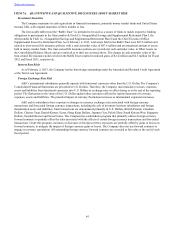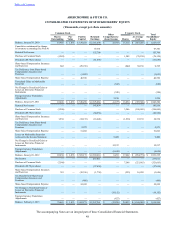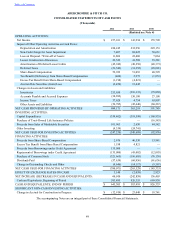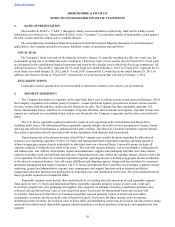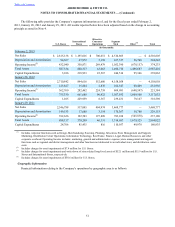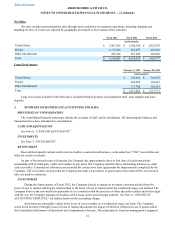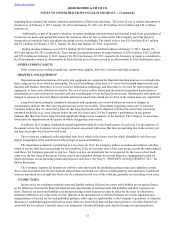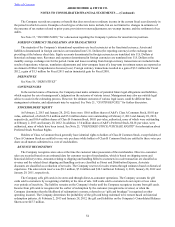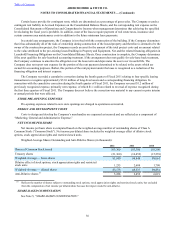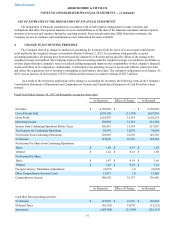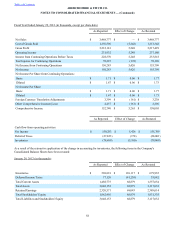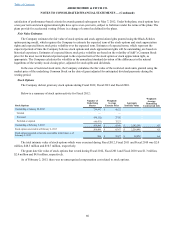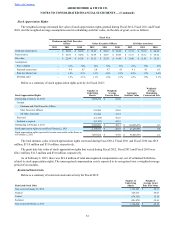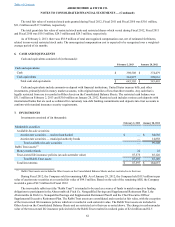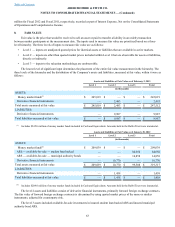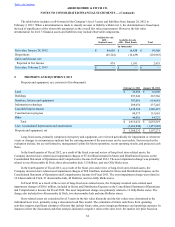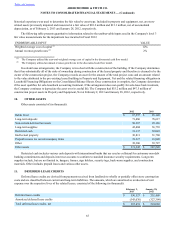Abercrombie & Fitch 2013 Annual Report Download - page 55
Download and view the complete annual report
Please find page 55 of the 2013 Abercrombie & Fitch annual report below. You can navigate through the pages in the report by either clicking on the pages listed below, or by using the keyword search tool below to find specific information within the annual report.
55
The Company is not required by law to escheat the value of unredeemed gift cards to the states in which it operates.
During Fiscal 2012, Fiscal 2011 and Fiscal 2010, the Company recognized other operating income for gift card breakage of
$6.9 million, $7.2 million and $7.8 million, respectively.
The Company does not include tax amounts collected as part of the sales transaction in its net sales results.
COST OF GOODS SOLD
Cost of goods sold is primarily comprised of: cost incurred to ready inventory for sale, including product costs, freight,
and import cost, as well as changes in reserves for shrink and lower of cost or market reserves. Gains and losses associated with
foreign currency exchange contracts related to hedging of inventory purchases are also recognized in cost of goods sold when
the inventory being hedged is sold.
STORES AND DISTRIBUTION EXPENSE
Stores and distribution expense includes store payroll, store management, rent, utilities and other landlord expenses,
depreciation and amortization, repairs and maintenance and other store support functions, as well as Direct-to-Consumer
expense and Distribution Center (“DC”) expense.
Shipping and handling costs, including costs incurred to store, move and prepare products for shipment, and costs
incurred to physically move the product to the customer, associated with direct-to-consumer operations were $78.6 million,
$53.6 million and $38.9 million for Fiscal 2012, Fiscal 2011 and Fiscal 2010, respectively. Handling costs, including costs
incurred to store, move and prepare the products for shipment to the stores were $59.4 million, $62.8 million and $42.8 million
for Fiscal 2012, Fiscal 2011 and Fiscal 2010, respectively. These amounts are recorded in Stores and Distribution Expense in
our Consolidated Statements of Operations and Comprehensive Income. Costs incurred to physically move the product to the
stores is recorded in Cost of Goods Sold in our Consolidated Statements of Operations and Comprehensive Income.
MARKETING, GENERAL & ADMINISTRATIVE EXPENSE
Marketing, general and administrative expense includes: photography and media ads; store marketing; home office
compensation, except for those departments included in stores and distribution expense; information technology; outside
services such as legal and consulting; relocation; recruiting; samples and travel expenses.
OTHER OPERATING EXPENSE (INCOME), NET
Other operating expense (income) consists primarily of the following: income related to gift card balances whose
likelihood of redemption has been determined to be remote; gains and losses on foreign currency transactions; business
interruption insurance recoveries; and the net impact of the change in valuation related to other-than-temporary impairments
associated with auction rate securities ("ARS"). See Note 7, “INVESTMENTS.”
WEBSITE AND ADVERTISING COSTS
Website and advertising costs related to direct-to-consumer operations are expensed as incurred as a component of Stores
and Distribution Expense on the Consolidated Statements of Operations and Comprehensive Income.
LEASES
The Company leases property for its stores under operating leases. Lease agreements may contain construction
allowances, rent escalation clauses and/or contingent rent provisions.
For construction allowances, the Company records a deferred lease credit on the Consolidated Balance Sheets and
amortizes the deferred lease credit as a reduction of rent expense on the Consolidated Statements of Operations and
Comprehensive Income over the terms of the leases.
For scheduled rent escalation clauses during the lease terms, the Company records minimum rental expense on a straight-
line basis over the terms of the leases on the Consolidated Statements of Operations and Comprehensive Income. The
difference between the rent expense and the amount payable under the lease is included in Accrued Expenses and Other
Liabilities on the Consolidated Balance Sheets. The term of the lease over which the Company amortizes construction
allowances and minimum rental expenses on a straight-line basis begins on the date of initial possession, which is generally
when the Company enters the space and begins construction.
Table of Contents ABERCROMBIE & FITCH CO.
NOTES TO CONSOLIDATED FINANCIAL STATEMENTS — (Continued)


